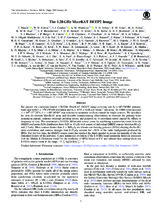| dc.description.abstract | We present the confusion-limited 1.28 GHz MeerKAT DEEP2 image covering one qb » ¢ 68 FWHM primarybeam area with θ = 7 6 FWHM resolution and s = m - n 0.55 0.01 Jy beam 1 rms noise. Its J2000 center position
α = 04h 13m 26 4, δ = −80° 00′ 00″ was selected to minimize artifacts caused by bright sources. We introduce
the new 64-element MeerKAT array and describe commissioning observations to measure the primary-beam
attenuation pattern, estimate telescope pointing errors, and pinpoint (u, v) coordinate errors caused by offsets in
frequency or time. We constructed a 1.4 GHz differential source count by combining a power-law count fit to the
DEEP2 confusion P(D) distribution from 0.25 to 10 μJy with counts of individual DEEP2 sources between 10 μJy
and 2.5 mJy. Most sources fainter than S ∼ 100 μJy are distant star-forming galaxies (SFGs) obeying the far-IR/
radio correlation, and sources stronger than 0.25 μJy account for ∼93% of the radio background produced by
SFGs. For the first time, the DEEP2 source count has reached the depth needed to reveal the majority of the star
formation history of the universe. A pure luminosity evolution of the 1.4 GHz local luminosity function consistent
with the Madau & Dickinson model for the evolution of SFGs based on UV and infrared data underpredicts our
1.4 GHz source count in the range -5 log Jy 4 [ ( )] S - | en_US |

